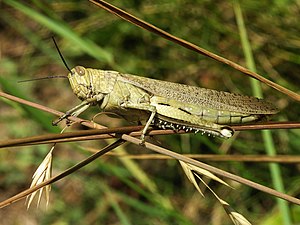Anacridium
| Anacridium | ||||||||||||
|---|---|---|---|---|---|---|---|---|---|---|---|---|

Egyptian migratory locust ( Anacridium aegyptium ) |
||||||||||||
| Systematics | ||||||||||||
|
||||||||||||
| Scientific name | ||||||||||||
| Anacridium | ||||||||||||
| Uvarov , 1923 |
Anacridium is agenus of locusts from the family of field locusts (Acrididae).
features
In living animals, the eyes are light reddish brown in color and have 7 or 8 dark longitudinal stripes. The eyes of dead animals are often monochrome. The weakly sunk fastigium is bordered on the sides by ledges. Calluses can run from these ridges to the ocelli , which cannot be seen from above. The side strips of the forehead rib are raised. The forehead rib usually diverges slightly in the direction of the base of the antennae and is sunk in from the ocellus. The facial keels are clearly visible. The antennas, which consist of 28 or 29 members, are colored light to dark brown. In the males they are about 2/3 longer than the Paranota , in the females by about half. In males and females, the longest antennae are twice as long as they are wide. From about the 11th antenna segment onwards, the segments are more densely dotted. The pronotum is obtuse-angled in front, obtuse-angled to slightly acute-angled behind. The raised central keel is often lighter. The disc (dorsal surface of the pronotum) slopes down from the central keel to the sulcus in a roof shape. The metazona is almost flat and wrinkled. The sulcus is roughly in the middle of the pronotum. The disc is cut through by all transverse furrows. The Paranota are steeply sloping. The process of the prosternum is slightly like a compressed fingertip. The sternas are wrinkled. The mesosternal space is approximately 1.5 times as long as it is wide. The Lobi are only about 20% wider. In males in particular, the metasternal space has a narrow stalk. No or only a hinted inclined bar is present on the third episternum. The species are macropter . The elytres tower above the rear knees by 15 to 25 millimeters. Basally, the Elytra have the basic color, apically they become lighter and there are small spots. Stridulation veins are missing. The glassy alae have a large brown spot in the middle of the anal fan . At rest they are just as long as the Elytra. There are sidebars on the first abdominal segment. The eardrum of the tympanic opening is inclined backwards. The posterior femora of the males are 4.3 to 4.5 times as long as they are high, while in the females they are about 5 times as long as they are high. The dorsal and ventral edge are finely serrated. The posterior tibia has 8 or 9 spines dorsally on the outside and 10 spines and an apical spine on the inside as a rule. The males' arolium is about half longer than the claws. In the females, however, it is only about a quarter longer.
Systematics
The genus includes the following 13 species. They occur predominantly in Africa, the Asian distribution extends east to Java. Only one species ( Anacridium aegyptium ) is native to Europe:
- Anacridium aegyptium (Linnaeus, 1764)
- Anacridium burri Dirsh & Uvarov, 1953
- Anacridium deschauenseei Rehn, 1941
- Anacridium eximium (Sjöstedt, 1918)
- Anacridium flavescens (Fabricius, 1793)
- Anacridium illustrissimum (Karsch, 1896)
- Anacridium incisum Rehn, 1942
- Anacridium javanicum Willemse, 1932
- Anacridium melanorhodon (Walker, 1870)
- Anacridium moestum (Serville, 1838)
- Anacridium rehni Dirsh, 1953
- Anacridium rubrispinum Bei-Bienko, 1948
- Anacridium wernerellum (Karny, 1907)
supporting documents
literature
- Kurt Harz: The orthopterists of Europe . Volume 2, Dr. W. Junk NV, The Hague 1975.
Individual evidence
- ↑ Anacridium in Fauna Europaea. Retrieved September 14, 2011
- ↑ Anacridium at Orthoptera Species File Online . Retrieved August 25, 2011
